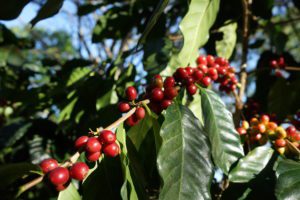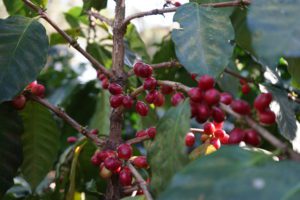Since coffee is such a common beverage, a popular misconception is that coffee plants are easy to grow. In reality, it’s a picky plant. Before talking specifically about how they grow, it’s important to clear up a few misconceptions about coffee. Our favorite beverage’s home base, the coffee plant, is full of surprises for many people. (After seeing the climate conditions coffee needs, North America’s reliance on importing coffee from Honduras, Mexico, Colombia and Brazil will seem natural.)
Misconceptions About Coffee

Another surprise for many people is that coffee isn’t a bean. In fact, it doesn’t grow on or near the ground. Coffee is actually the seed inside of a coffee fruit—called a coffee cherry. It’s a pit inside that could actually produce another coffee plant. Another attribute of coffee plants, besides the bright red cherries, are small white flowers. They are truly trees, not beans. In fact, they’re trees that can grow to over 15 feet naturally. One species can grow double that!
Since coffee grows in hot countries near the equator, many people unfamiliar with coffee origins and different types of beans don’t realize that altitude is very important. It determines the outcome and tastiness of the beans. Many Americans envision it growing near the beach in Central America, South America or Indonesia. In fact, these regions have hills and mountains. That’s where coffee thrives. It tends to taste better when grown over a certain altitude threshold.
Many people also have a low estimate of the number of factors that impact the taste of straight beans or grounds. There are many more differences than just the coffee roast profile. Usually, only serious coffee aficionados and baristas can recount all of the factors influenced by coffee. While it’s true that a light roast may taste light years away from a French or dark roast, many coffee flavor factors exist to be experimented with…or controlled. Other levers on flavor include the altitude, the amount of rainfall, the soil quality, volcanic matter in the soil and the amount of sunlight. When roasting coffee, many additional little levers exist. The roasting process should be planned ahead of time according to the properties of the beans. Roasting is a science unto itself. Roasters should assess the properties of the beans, like density, to plan the temperature and time spent roasting. Dark roasts don’t have more caffeine than light roasts. There are also two species of coffee plants—Arabica and Robusta. If you’re an aspiring barista or are delving into coffee culture, or just love plants, you’ll want to read about these two and how they are synthesized into blends.
How Coffee Plants Grow
Coffee trees naturally grow tall, depending on their species. Arabica coffee plants can naturally reach 15 feet. Meanwhile, the hardier but less tasty (unless you like bitter espresso) Robusta plant can soar to over 30 feet. The problem with both species reaching their heights is it becomes unmanageable to pick the coffee fruit. To solve this, they’re usually pruned to around 6 feet when living out in nature. In fact, they may be pruned to more of a bush size. Some people grow them indoors like house plants. There is a dwarf variety well-suited to this purpose. Coffee plants can live for 65 years, so do plan your planting situation accordingly!
Climate
The main thing to keep in mind about coffee plants is their ideal conditions. Coffee only grows well in latitudes near the equator. The ideal place is in the mountains in a hot climate known as siempre primavera or “forever spring,” at least in Latin America. For this reason, controlling the temperature and humidity is vital for home coffee plants. Coffee plants prefer temperatures between 70 and 80 degrees. If the environment isn’t naturally humid, they’ll need to be misted with water regularly. They don’t do well when placed directly near heat or air conditioning. They also need regular watering. Keeping their soil at least moist at all times is key. Coffee plants can get overwatered, although you may water them as many as three times per week. Since coffee plants grow in the mountains, ensuring their soil is well-draining is key. However, they’re not like succulents that need a hole for the water to drain out of immediately.
Sunlight
Controlling the amount of light that coffee plants receive is vital to their survival and health. That’s because they naturally grow below taller plants in the rainforest. Pretty unambitious in terms of their tanning aspirations, replicating the low-direct-sunlight situation is important. In addition to stopping growth below the rainforest canopy, they also thrive in areas that tend to be overcast and even foggy.
After sprouting, baby coffee plants can’t handle direct sunlight. Once it’s past the seedling phase, a coffee plant can stay indoors or venture outside. They must venture…into a shady area though. Some people have success covering the plant with plastic wrap to avoid direct sunlight. They are a particular, equatorial plant. Their leaves will turn brown after too much direct sunlight.
Patience and Flowers
Coffee plants…certainly don’t wow growers quickly with flowers and cherries. Those hoping to grow coffee trees outdoors or have a houseplant-style coffee pet must be in it for the long haul. The flowers don’t arrive until year three or later. However, a healthy coffee plant produces pretty, aromatic white flowers. A full-sized coffee tree can look like a rhododendron or azalea with white flowers when blooming. Luckily, they are pretty plants in the meantime, before they flower. It’s fun to have a coffee plant around too. For them to grow their magnificent red cherries, they must be outside. The flowers actually do contain caffeine. Nevertheless, any part of the plant besides the bean, or coffee cherry, shouldn’t be eaten or made into a drink. The flowers would need to be processed before consumption.
Planting Outside
After having a cool young coffee plant, you may be tempted to plant it outside, and even germinate friends for it. Beware, if you do plant them outside, they will not stay bush-sized—they will shoot up a few more feet. After pruning, they grow in more fully. Basing your planting decisions around whether or not you want it to produce berries, and whether you’ll use the seeds regularly is important. For planting outside, researching more will help you plan. This is key if you don’t live in the southern US or one of the coffee-producing islands. Growing coffee plants is difficult, it’s not suited to areas too far above the equator.
Coffee

We could talk about growing coffee plants, their flowers and fruit all day. However, we must mention the end result of our coffee plants that grow coffee under the ideal conditions we carefully created and control. At Subida Coffee Co., the people involved in importing coffee from Honduras recognize that we are changing the reputation of Honduran coffee. With gourmet coffee reflecting the richness of the higher altitudes in Honduras, Subida is helping put Honduran coffee on the coffee world map. In addition, our coffee sales support the excellent cause of empowering the next generation in Honduras through education, training and life skills. Outside of Honduras, Copan coffee is even beginning to get a name for itself as an important Central American coffee-growing area.

